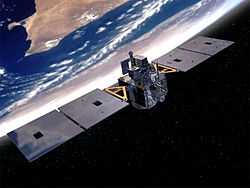- MightySat-2
-
MightySat-2 Operator AFRL Major contractors General Dynamics Mission type Technology demonstrator Satellite of Earth Launch date July 19, 2000 Launch vehicle Minotaur I Launch site Vandenberg AFB Mission duration 2 years 4 month Orbital decay November 2002 COSPAR ID 2000-042A Mass 130 kg Power 330 W Orbital elements Regime Low Earth orbit Eccentricity 0.0026639786 Inclination 97.8° Apoapsis 585.0 km Periapsis 548.0 km Orbital period 96.0 min Instruments Main instruments Fourier Transform Hyperspectral Imager
MightySat-2 (or Sindri) was a small spacecraft developed by the Air Force Research Laboratory[1] to test advanced technologies in imaging, communications, and spacecraft bus components in space.Contents
Design
MightySat II.1 was manufactured by General Dynamics in a modular approach, using, e.g., VME-based subsystems, and a planar payload deck for small experimental payloads. The satellite measured 0.67m x 0.83m x 0.86m (WxLxH) and had a launch weight of 123.7 kg (Bus Mass: 87.1 kg). Power was provied by 2-axis articulated Si solar arrays with an designed end-of-life power output of 330 W. The Attitude Determination and Control Subsystem featured a 3-axis zero-momentum-bias reaction wheel assembly with a Sun sensor, a star tracker and inertial measurement units, delivering an attitude jitter of 15.7 arcsec/sec, and poiting accuracy and knowledge of 648 and 540 arcsec, respectively. The communication was compatible with the US Air Force Space-Ground Link System with data rates of 1 Mbps for payload/experiments data downlink, 2.0 kbps for Command uplink, and 20 kbps for Telemetry downlink. Computing and data handling was done by a RAD6000 CPU @ 20 MIPS with a IEEE VME backplane 128 MByte CPU RAM, and a 21.6 MBytes/sec transfer rate, and a 2 Gbit Solid State Recorder for Science Data. Among its 10 experiments was a Fourier Transform Hyperspectral Imager.[2]
Mission
MightSat II.1 ws launched on July 19, 2000 with a Minotaur I. It deorbited in November 2002 due to natural decay of its orbit, exceeding more than twice its nominal lifetime.[2]
Payload and experimental instruments[2]
Stand-Alone Experiments/Sensors
- Kestrel Fourier Transform (Visible) Hyperspectral Imager
- Quad TMS320C40 (QC40) Floating Point Digital Signal Processor
- DARPA-Aerospace sponsored PicoSat Launcher Assembly
- Shape Memory Alloy Thermoelastic Tailoring Experiment
- Starfire optical reflectors for use with Kirtland’s Starfire Optical Range
Engineering/Experimental Bus Components
- The NRL miniature SGLS Transponder (known as the NSX)
- The Multi-functional Composite Bus Structure
- Solar Array Concentrator
- Advanced Composite Solar Array Substrate
- Solar Array Flexible Interconnect
References
- ^ "MightySat II.1 Datasheet" (PDF). General Dynamics. http://www.gd-ais.com/capabilities/offerings/marketing/MightySatdatasheet.pdf. Retrieved 2008-08-01.
- ^ a b c "MightySat II.1: a standard-interface demonstration smallsat" (PDF). General Dynamics. 2005-11-05. http://www.gd-space.com/documents/Mightysat%20051105A%20(SS).pdf. Retrieved 2010-12-22.
Spacecraft developed by the Air Force Research LaboratoryLaunch/orbital vehicles X-33 Venture Star (officially canceled) · HTV-3X Blackswift (canceled) · X-37 Orbital Test Vehicle · X-40A Space Maneuver Vehicle · X-51A WaveRiderUniversity Nanosat Program Space weather satellites Technology demonstrators TAOS · MightySat-1 · MightySat-2 · XSS-10 · TechSat-21 (canceled) · XSS-11 · ISAT · PnPSat-1 (canceled) · ANGELSTactical Satellite Program satellites Categories:- Spacecraft
- Spacecraft launched by Minotaur rockets
- United States spacecraft stubs
Wikimedia Foundation. 2010.

